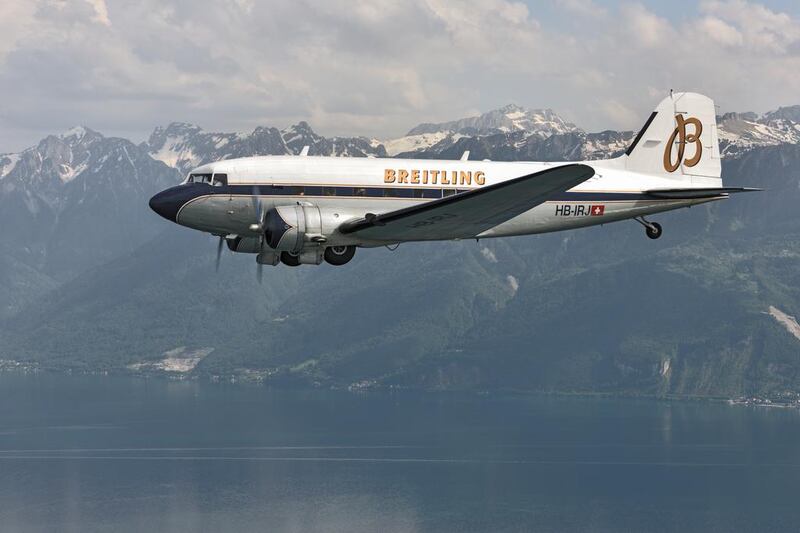Sitting on board the Breitling DC-3 World Tour plane on the tarmac of Dubai’s Al Maktoum International Airport, I watch the left propeller start, the blades juddering slightly before becoming a spinning blur. The plane starts to vibrate as the engine settles into a rhythm. This is different from modern aircraft, which feel heavy and welded to the ground. This elderly little plane is skittish and light, as if eager to be airborne. A few minutes later, the second engine splutters to life. Our race down the runway lifts the tail section first, and for a few glorious seconds I am levitating at 85 knots. With a final high-pitched whine, we are in the air.
Albeit for only about 20 minutes or so, I am part of Breitling’s world-record attempt to fly a vintage airplane around the globe.
Since Gaston Breitling created one of the world’s first wristwatch chronographs back in 1915, giving pilots their earliest wrist instruments, Breitling has enjoyed a close relationship with the world of aviation. In 1936, it became the official supplier to the Royal Air Force, so it seems only fitting that the brand’s own plane should have such military pedigree.
Breitling chose the legendary Douglas DC-3 aircraft, which was first built in the United States in 1935, and marked a turning point for the aviation industry. Before the DC-3, flying was uncomfortable and dangerous, and largely restricted to carrying mail across the country. With reliable engines and sturdy cabins, the DC-3 offered a safer, smoother journey, and with it, passenger flights quickly became accessible. Soon, the DC-3 was operating as the world’s first commercial airplane, and was affectionately nicknamed the “gooney bird”.
With the outbreak of the Second World War, the DC-3 became a workhorse, and it was used to tow gliders, as a flying hospital and to deliver troops to the D-Day Normandy landings in 1944.
Breitling’s own DC-3 took its maiden flight in 1940, working first as a commercial plane, before being turned into a troop carrier during the war. The 1950s saw it revert to commercial flights around Miami, until it was retired in the 1980s. Breitling bought it in 2008, and began a long and costly restoration process. Now, returned to its former glory, but bristling with modern technology, Breitling’s DC-3 has embarked on an audacious, record-breaking attempt to become the oldest plane to circumnavigate the Earth.
Piloted by Captain Francisco Agullo, the plane left the Breitling headquarters in Switzerland last month, on March 9, exactly 77 years to the day since it first took to the skies, and set off on a journey that will take six months to complete. Stopping in 55 cities in more than 28 countries, the journey will be a challenge for both man and machine, because, having already clocked up 74,500 flying hours, the elderly plane needs 100 hours of maintenance for every one hour of flight. One particular leg of the journey, between Japan and a US naval base in the Atlantic, involves a non-stop flight of 11 hours, while the maximum flying time of the DC-3 is only eight. Even with an expert crew and the additional fuel carried on board, this will be a truly daunting test.
I was lucky to be invited aboard on the Dubai leg of the journey, and was immediately struck by the sheer beauty of this plane. With her graceful lines, quaint square windows and old-fashioned prop engines, she speaks of a bygone age of romance and adventure. Tilted backwards with her nose proudly in the air, the plane makes me think that what modern air travel may have gained in speed, comfort and convenience, it has lost in grace and style.
I ask Captain Agullo if the DC-3 is easy to fly, and his face lights up. “There is such a connection with the machine,” he explains. “With no assisted steering, when it is windy, we both have to really fight with the controls. But, yes,” he adds with sparkling eyes, “it is so much fun.”
One hazard is that the DC-3 is considerably slower than the modern private jets it shares runways with, making arrivals into busy airports a tricky business for all concerned. An upside, however, is the radio chatter as surrounding pilots express their delight at seeing the restored plane.
The around-the-world journey is not just a pleasure trip; there is a humanitarian element, too. As well as giving aviation enthusiasts the chance to see one of the last planes of its kind, Breitling is working with the United Nations International Children’s Emergency Fund to help underprivileged children in India and Japan, including those affected by the tsunami. For every nautical kilometre completed by the plane, Breitling will donate US$2 (Dh7.5) to Unicef.
To commemorate this amazing adventure, Breitling has also created a limited-edition series of 500 Navitimer Breitling DC-3 chronograph watches. With a Manufacture Breitling Caliber 01 movement, in a 46-millimetre steel case, each numbered watch will come with a pilot's logbook from the momentous flight. However, anyone wishing to buy one will have to wait until the journey ends in September, because the watches are being carried on board, as an integral part of this once-in-a-lifetime expedition.
Read this and more stories in Luxury magazine, out with The National on Thursday, April 13.
smaisey@thenational.ae





